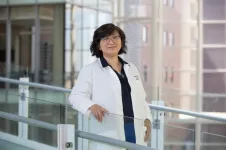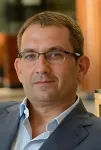(Press-News.org) Even as the nation’s opioid epidemic continues to ravage families and communities nationwide — with more than 100,000 Americans dying of drug overdoses each year — stigma remains a barrier for many people accessing treatment for addiction.
A new study from Oregon Health & Science University suggests telehealth may be an important antidote to overcoming stigma and reducing barriers for people seeking out the treatment they need.
The study, published recently in the Harm Reduction Journal, compiled in-depth interviews with 30 people treated for substance use disorder at OHSU from March of 2020 to December of 2021. Due to the COVID-19 pandemic, federal regulations eased the ability of people to enter treatment through virtual visits during that time, as opposed to having to visit a clinic in person.
“You feel like you’re being watched or judged by everyone, and telehealth can reduce that sense whether it’s real or perceived,” said senior author Ximena Levander, M.D., assistant professor of medicine (general internal medicine and geriatrics) in the OHSU School of Medicine. “Telehealth can lower that barrier.”
Patients reported that they appreciated the implicit sense of autonomy and trust involved in being able to connect with clinicians through video or telephone visits. Patients received prescriptions for buprenorphine, a partial opioid receptor agonist that inhibits opioid withdrawal symptoms.
Co-authors identified four themes among patients interviewed in the study:
Autonomy: Telehealth offers improved control over the treatment setting.
Patient-centered: Concern over stigma and privacy can cut both ways: In some cases, patients preferred in-person visits, especially if they live in congregant settings where others might see or hear their virtual visit.
Social distancing: The social distance of telehealth presents an opportunity to reduce or worsen perceptions of stigma by clinicians — especially if patients perceive the clinician isn’t fully paying attention or maintaining eye contact.
Flexibility: Patients reported the flexibility of telehealth translated into perceptions of increased trust and respect from clinicians.
“Our results support a more individualized approach to care, whereby patients may choose whether they receive care in person or via telehealth,” the authors write. “Given that aspects of both telehealth and in-person treatment left some participants feeling judged by their clinicians, our findings also highlight the need to further explore how clinicians perpetuate stigma through telehealth-based programs, and how training and clinical guidelines could mediate this.”
In addition to Levander, OHSU co-authors included Jessica V. Couch, Mackenzie Whitcomb, M.D., Bradley M. Buchheit, M.D., David A. Dorr, M.D., Darren J. Malinoski, M.D., Todd Korthuis, M.D., and Sarah S. Ono, Ph.D.
The research was supported by the Agency for Healthcare Research and Quality, grant award K12 HS026370, the National Institute on Drug Abuse of the National Institutes of Health, grant awards UH3DA044831, UG1DA015815 and National Center For Advancing Translational Sciences of the National Institutes of Health grant award UL1TR002369; and a seed award through the OHSU Division of General Internal Medicine’s Section of Addiction Medicine.
END
Study: Telehealth builds autonomy, trust in treating addiction
Stigma remains a barrier to those seeking treatment for opioid use disorder
2024-07-09
ELSE PRESS RELEASES FROM THIS DATE:
New carbon storage technology is fastest of its kind
2024-07-09
A new way to store carbon captured from the atmosphere developed by researchers from The University of Texas at Austin works much faster than current methods without the harmful chemical accelerants they require.
In new research published in ACS Sustainable Chemistry & Engineering, the team developed a technique for ultrafast formation of carbon dioxide hydrates. These unique ice-like materials can bury carbon dioxide in the ocean, preventing it from being released into the atmosphere.
“We’re staring at a huge challenge — finding a way ...
Socioeconomic status significantly affects fertility treatment outcomes, new study shows
2024-07-09
Novel research, presented today at the ESHRE 40th Annual Meeting in Amsterdam, reveals significant social disparities in achieving live births following assisted reproductive technology (ART) treatment. Women with a research education (PhD) were over three times more likely to achieve a live birth compared to those with a primary school education, while women in the highest income group were twice as likely than those in the lowest income group [1].
Conducted by researchers from the University of Copenhagen and Copenhagen University Hospital (Rigshospitalet), the national, register-based study analysed data from 68,738 women aged 18-45 who underwent ...
IVF and IUI treatment cycles increase across Europe, along with stable pregnancy rates
2024-07-09
Women in Europe are receiving more cycles of in vitro fertilisation (IVF) and intrauterine insemination (IUI), according to data presented today at the ESHRE 40th Annual Meeting in Amsterdam [1].
Preliminary data from the ESHRE European IVF Monitoring (EIM) Consortium [2] reveals a steady and progressive rise in the use of Assisted Reproductive Technology (ART). In 2021, a total of 1 103,633 ART treatment cycles were reported by 1,382 clinics across 37 European countries – a 20% increase from the 919,364 cycles reported in 2020, keeping in mind that this was the year COVID affected the number ...
New 3D imaging method offers promise of better IVF outcomes
2024-07-09
Innovative research, presented today at the ESHRE 40th Annual Meeting in Amsterdam, has introduced a novel 3D imaging model designed to identify features of blastocysts – the early stage of development for an implanted embryo – associated with successful pregnancies. This new approach could transform current blastocyst selection methods, and open avenues for increased pregnancy rates [1].
The shape and structure of blastocysts can predict the success of a pregnancy, aiding blastocyst selection for in vitro fertilisation (IVF). However, selecting ...
Brain & Life® announces new Editor-in-Chief
2024-07-08
MINNEAPOLIS – The American Academy of Neurology (AAN) has named a new editor-in-chief of Brain & Life®, its free patient and caregiver magazine, website and podcast. Sarah Song, MD, MPH, FAAN, an associate professor in the department of neurological sciences at Rush University Medical Center in Chicago, will succeed Editor-in-Chief Orly Avitzur, MD, MBA, FAAN, who will complete her 10-year term on December 31, 2024.
Song, a Fellow of the American Academy of Neurology, will be the third editor-in-chief of Brain & Life since the publication began in ...
University of Cincinnati study: Brain organ plays key role in adult neurogenesis
2024-07-08
University of Cincinnati researchers have pioneered an animal model that sheds light on the role an understudied organ in the brain has in repairing damage caused by stroke.
The research was published July 2 in the Proceedings of the National Academy of Sciences and sought to learn more about how the adult brain generates new neurons to repair damaged tissue.
The research team focused on the choroid plexus, a small organ within brain ventricles that produces the brain’s cerebrospinal fluid (CSF). CSF circulates throughout ...
Small molecules induce trained immunity, opening a new approach to fighting disease
2024-07-08
Vaccines provide a front-line defense against dangerous viruses, training adaptive immune cells to identify and fight specific pathogens.
But innate immune cells — the first responders to any bodily invader — have no such specific long-term memory. Still, scientists have found that they can reprogram these cells to be even better at their jobs, potentially fighting off seasonal scourges like the common cold or even new viral diseases for which vaccines have not yet been developed.
A University of Chicago Pritzker School of Molecular Engineering (PME) team has found several small molecule candidates that induce this trained immunity without the ...
Erasing “bad memories” to improve long term Parkinson’s disease treatment
2024-07-08
BIRMINGHAM, Ala. — Common treatments for Parkinson’s disease can address short-term symptoms but can also cause extensive problems for patients in the long run. Namely, treatments can cause dyskinesia, a form of uncontrollable movements and postures.
In a recent study published in The Journal of Neuroscience, researchers at the University of Alabama at Birmingham took a different approach to dyskinesia and treated it like a “bad motor memory.” They found that blocking a protein called Activin A could halt dyskinesia symptoms ...
Restored oyster sanctuaries host more marine life
2024-07-08
In the campaign to restore Chesapeake Bay, oyster sanctuaries rank among the most hotly contested strategies. But new research suggests these no-harvest areas are working, and not only for the oysters. In a new study published July 4 in Marine Ecology Progress Series, Smithsonian biologists discovered oyster sanctuaries contain more abundant populations of oysters and other animal life—and the presence of two common parasites is not preventing that.
Oysters form the backbone of Chesapeake Bay. Besides injecting millions of dollars into the regional economy each year, they also act as vital habitat and filter feeders that clean the water. But their populations ...
Research spotlight: Machine learning helps identify patients at varying levels of risk for opioid use disorder
2024-07-08
Ronen Rozenblum, PhD, MPH, director of the Unit for Innovative Healthcare Practice & Technology and director of Business Development of the Center for Patient Safety Research and Practice at Brigham and Women's Hospital, and an assistant professor at Harvard Medical School, is the principal investigator and senior author of a new study published in JMIR Medical Informatics, “A Machine Learning Application to Classify Patients at Differing Levels of Risk of Opioid Use Disorder: Clinician Based ...
LAST 30 PRESS RELEASES:
Key lung immune cells can intensify allergic reactions
Do hormones explain why women experience more gut pain?
New materials conduct ions in solids as easily as in liquids
Breakthrough of the Year: Renewable energy begins to eclipse fossil fuel-based sources
LLM use is reshaping scientific enterprise by increasing output, reducing quality and more
Introducing LightGen, a chip for ultra-fast, ultra-efficient generative AI
Astronomers see fireworks from violent collisions around nearby star
ACC/AHA issue new guideline on managing congenital heart disease in adults
Cosmic crash caught on camera
Is talented youth nurtured the wrong way? New study shows: top performers develop differently than assumed
Ants: An untapped resource in the development of antibiotics?
Archaeologists use AI to create prehistoric video game
Mitochondria migrate toward the cell membrane in response to high glucose levels
Tiny viral switch offers hope against drug-resistant bacteria
Most parents aware of early peanut introduction guidelines, but confused about details
HPV vaccine can protect against severe lesions of the vulva and vagina
Virtual care provision and emergency department use among children and youth
Quadrivalent HPV vaccine and high-grade vulvovaginal lesions
Insights into dry eyes gained from stem cell-derived tear glands
Researchers identify 166 human pluripotent stem cell lines available for use in clinical applications
Europa Clipper instrument uniquely observed interstellar comet 3I/ATLAS
UN University Report challenges climate change as sole trigger of Syrian Civil War, exposing governance failures in drought response
Real estate investment trust (REIT) acquisition associated with hospital closure and bankruptcy
New Raman imaging system detects subtle tumor signals
Boston Children’s receives a $7.5 million grant from Aligning Research to Impact Autism (ARIA) to provide clinical research coordination for the IMPACT Network
Spray-on antibacterial coating offers new protection for plants against disease and drought
ESMT Berlin study: What makes a first offer successful in negotiations
Groundbreaking ceremony marks the beginning of CTAO-South Array construction in Chile
Why swearing makes you stronger
What prevents more cancer patients from enrolling in potentially life-saving clinical trials?
[Press-News.org] Study: Telehealth builds autonomy, trust in treating addictionStigma remains a barrier to those seeking treatment for opioid use disorder



